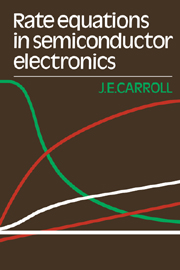Book contents
- Frontmatter
- Contents
- Preface
- 1 Introduction to rate equations
- 2 Elementary rate equations in semiconductors
- 3 Rates of switching
- 4 Rates of change and transfer in phase space
- 5 Rate equations in quantum electronics
- 6 Rate equations in optoelectronic devices
- 7 Advanced topics in rate equations
- Appendix A Counting states
- Appendix B Notes on differences between gas and diode laser rate equations
- Notes on solutions
- References
- Index
3 - Rates of switching
Published online by Cambridge University Press: 04 December 2009
- Frontmatter
- Contents
- Preface
- 1 Introduction to rate equations
- 2 Elementary rate equations in semiconductors
- 3 Rates of switching
- 4 Rates of change and transfer in phase space
- 5 Rate equations in quantum electronics
- 6 Rate equations in optoelectronic devices
- 7 Advanced topics in rate equations
- Appendix A Counting states
- Appendix B Notes on differences between gas and diode laser rate equations
- Notes on solutions
- References
- Index
Summary
The simple switch: an introduction
In the hope of avoiding analysis for its own sake, some of the ideas of the preceding chapter are applied to the dynamics of semiconductor switching devices which are important in computer and communication systems. Most texts on semiconductor devices concentrate on impurities, Fermi levels, diffusion equations and equilibrium starting conditions. In the approach here, the chief concerns are the rates at which a device can transport charge. So RC time constants, the dielectric relaxation rate, transit times and rates of recombination are the quantities that appear in approximate dynamic analyses of the selected switching devices. There is an inevitable tendency to digress from one or two themes of rate equations into standard semiconductor physics, and the forbearance of the reader is requested when the digressions into physics are too lengthy, inadequate or both.
Digital communications and computations rely on transmitting information by electromagnetic pulses (electrical, microwave or optical) which are either ‘on’ or ‘off’. In section 1.6 it was seen that such binary signals helped to maximise the probable information of a single symbol. Moreover, encoding signals into pulses leads to more accurate detection, regeneration and transmission of data through a variety of techniques such as error correcting codes, which can combat interference or noise in a transmission path. Faster switching rates lead to shorter pulses and so to higher rates of data and information processing.
An ideal switch between a load and a source would transfer power instantaneously to the load, but we remind the reader here how switches and loads have, of necessity, lead and contact resistances with stray capacitances which limit the rate of transfer of charge to the load.
- Type
- Chapter
- Information
- Rate Equations in Semiconductor Electronics , pp. 33 - 59Publisher: Cambridge University PressPrint publication year: 1986



